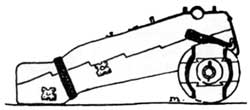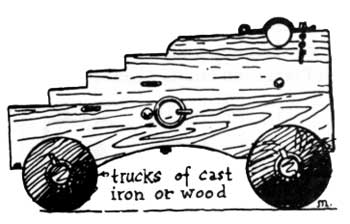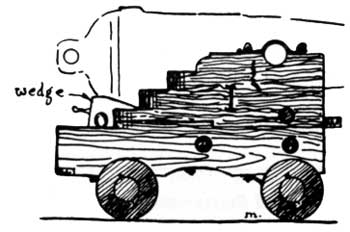|
ARTILLERY THROUGH THE AGES A Short Illustrated History of Cannon, Emphasizing Types Used in America |
 |
THE CHARACTERISTICS OF CANNON (continued)
GARRISON AND SHIP GUNS
Cannon for permanent fortifications were of various sizes and calibers, depending upon the terrain that had to be defended. At Castillo de San Marcos, for instance, the strongest armament was on the water front; lighter guns were on the land sector, an area naturally protected by the difficult terrain existing in the colonial period.

FIGURE 28—EIGHTEENTH CENTURY SPANISH GARRISON GUN.
Before the Castillo was completed, guns were mounted only in the bastions or projecting corners of the fort. A 1683 inventory clearly shows that heaviest guns were in the San Agustín, or southeastern bastion, commanding not only the harbor and its entrance but the town of St. Augustine as well San Pablo, the northwestern bastion, overlooked the land approach to the Castillo and the town gate; and, though its armament was lighter, it was almost as numerous as that in San Agustín. Bastion San Pedro to the southwest was within the town limits, and its few light guns were a reserve for San Pablo. The watchtower bastion of San Carlos over looked the northern marshland and the harbor; its armament was likewise small. The following list details the variety and location of the ordnance:
| Location | No. | Caliber | Class | Metal | Remarks |
| In the bastion of San Agustín | 1 1 2 1 1 1 1 1 1 |
40-pounder 18-pounder 16-pounder 12-pounder 12-pounder 8-pounder 7-pounder 4-pounder 3-pounder |
Cannon . . do . . . . do . . . . do . . . . do . . . . do . . . . do . . . . do . . . . do . . |
Bronze . . do . . Iron Bronze Iron Bronze Iron . . do . . Bronze |
Carriage battered. New carriage. Old carriages, wheels bad. New carriage. do. Old carriage. Carriage bad. New carriage. do. |
| In the bastion of San Pablo | 1 1 2 1 1 1 |
16-pounder 10-pounder 9-pounder 7-pounder 7-pounder 5-pounder |
Demicannon. Demiculverin. Cannon Demiculverin Cannon do |
Iron Bronze Iron Bronze Iron do |
Old carriage. do. do. do. Carriage bad. New carriage. |
| In the bastion of San Pedro | 1 2 2 1 |
9-pounder 7-pounder 5-pounder 4-pounder |
Cannon do. do. do |
Iron do do Bronze |
Old carriage. Carriage bad. do. Old carriage. | In the bastion of San Carlos | 1 1 1 1 |
10-pounder 5-pounder 5-pounder 2-pounder |
Cannon do. do. do. |
Iron do Bronze Iron |
Old carriage. New carriage. Good carriage. New carriage. |
The total number of Castillo guns in service at this date was 27, but there were close to a dozen unmounted pieces on hand, including a pair of pedreros. The armament was gradually increased to 70-odd guns as construction work on the fort made additional space available, and as other factors warranted more ordnance. Below is a summary of Castillo armament through the years:
| Kind of gun | 1683 | 1706 | 1740 | 1763 | 1765 | 1812 | 1834 | |||||||
| Iron | Bronze | Iron | Bronze | Iron | Bronze | Iron | Bronze | Iron | Bronze | Iron | Bronze | Iron | Bronze | |
| 2-pounder | 1 | .. | .. | + | .. | .. | .. | .. | .. | .. | .. | .. | .. | .. |
| 3-pounder | .. | 1 | .. | + | 2 | 3 | .. | .. | .. | .. | .. | .. | .. | .. |
| 4-pounder | 1 | 1 | * | + | 5 | 1 | .. | .. | .. | .. | 1 | .. | .. | .. |
| 5-pounder | 4 | 1 | * | + | 15 | 1 | .. | .. | .. | .. | .. | .. | .. | .. |
| 6-pounder | .. | .. | * | + | 5 | .. | .. | .. | .. | 1 | .. | .. | 3 | .. |
| 7-pounder | 4 | 1 | * | + | 5 | 2 | .. | .. | .. | .. | .. | .. | .. | .. |
| 8-pounder | .. | 1 | * | + | 11 | 1 | 5 | 11 | .. | .. | 1 | .. | .. | .. |
| 3-1/2-in. carronade | .. | .. | * | + | .. | .. | .. | .. | .. | .. | 4 | .. | .. | .. |
| 9-pounder | 3 | .. | * | + | .. | .. | .. | .. | .. | .. | .. | .. | .. | .. |
| 10-pounder | 1 | 1 | * | + | .. | .. | 6 | .. | .. | .. | .. | .. | .. | .. |
| 12-pounder | 1 | 1 | .. | + | .. | .. | 13 | .. | 7 | .. | 2 | .. | .. | .. |
| 15-pounder | .. | .. | .. | + | 6 | .. | .. | .. | .. | .. | .. | .. | .. | .. |
| 16-pounder | 3 | .. | .. | + | .. | .. | 2 | 1 | .. | .. | 8 | .. | .. | .. |
| 18-pounder | .. | 1 | .. | .. | 4 | 1 | 7 | .. | .. | .. | .. | .. | 4 | .. |
| 24-pounder | .. | .. | .. | .. | 2 | .. | 7 | .. | 32 | .. | 10 | .. | 5 | .. |
| 33-pounder | .. | .. | .. | .. | .. | 1 | .. | .. | .. | .. | .. | .. | .. | .. |
| 36-pounder | .. | .. | .. | 1 | .. | .. | .. | 1 | .. | .. | .. | .. | .. | .. |
| 40-pounder | .. | 1 | .. | .. | .. | .. | .. | .. | .. | .. | .. | .. | .. | .. |
| 24-pounder field howitzer | .. | .. | .. | .. | .. | .. | .. | .. | .. | .. | .. | .. | 2 | 2 |
| 6-in. howitzer | .. | .. | .. | .. | .. | .. | .. | .. | .. | .. | .. | 2 | .. | 2 |
| 8-in. howitzer | .. | .. | .. | .. | .. | .. | .. | .. | .. | 2 | .. | .. | .. | .. |
| Small mortar | .. | .. | .. | .. | .. | .. | .. | 18 | .. | 20 | .. | .. | .. | .. |
| 6-in. mortar | .. | .. | .. | .. | .. | .. | .. | .. | .. | .. | .. | 1 | .. | 1 |
| 9-in. mortar | .. | .. | .. | .. | .. | .. | .. | .. | .. | .. | .. | 1 | .. | .. |
| 10-in. mortar | .. | .. | .. | .. | .. | .. | .. | .. | .. | .. | .. | .. | .. | 1 |
| Large mortar | .. | .. | .. | .. | .. | .. | .. | 6 | .. | 1 | .. | .. | .. | .. |
| Stone mortar | 2 | .. | .. | .. | .. | .. | .. | .. | .. | .. | .. | 3 | .. | .. |
| Total | 20 | 9 | 26 | 9 | 55 | 10 | 40 | 37 | 39 | 24 | 26 | 8 | 14 | 6 |
| Grand total | 29 | 35 | 65 | 77 | 63 | 34 | 20 | |||||||
*26 guns from 4- to 10- pounders.
+8 guns from 2- to 16-pounders.
This tabulation reflects contemporary conditions quite clearly. The most serious invasions of Spanish Florida took place during the first half of the eighteenth century, precisely the time when the Castillo armament was strongest. While most of the guns were in battery condition, the table does have some pieces rated only fair and may also include a few unserviceables. Colonial isolation meant that ordnance often served longer than the normal 1,200-round life of an iron piece. A usual failure was the development of cracks around the vent or in the bore. Sometimes a muzzle blew off. The worst casualties of the 1702 siege came from the bursting of an iron 16-pounder which killed four and seriously wounded six men. At that periods incidentally, culverins were the only guns with the range to reach the harbor bar some 3,000 yards away.
Although when the Spanish left Florida to Britain in 1763 they took serviceable cannon with them, two guns at Castillo de San Marcos National Monument today appear to be seventeenth century Spanish pieces. Most of the 24- and 32-pounder garrison cannon, however, are British-founded, after the Armstrong specifications of the 1730's, and were part of the British armament during the 1760's. Amidst the general confusion and shipping troubles that attended the British evacuation in 1784, some ordnance seems to have been left behind, to remain part of the defenses until the cession to the United States in 1821.
The Castillo also has some interesting United States guns, including a pair of early 24-pounder iron field howitzers (c. 1777-1812). During the 1840's the United States modernized the defenses of Castillo (then known as Fort Marion) by constructing a water battery in the moat behind the seawall. Many of the guns for that battery are extant, including 8-inch Columbiads, 32-pounder cannon, and 8-inch seacoast and garrison howitzers. St. Augustine's Plaza even boasts a converted 32-pounder rifle.

FIGURE 29—VAUBAN'S MARINE CARRIAGE (c.1700).
Garrison and ship carriages were far different from field, siege, and howitzer mounts, while mortar beds were in a separate class entirely. Basic proportions for the carriage were obtained by measuring (1) the distance from trunnion to base ring of the gun, (2) the diameter of the base ring, and (3) the diameter of the second reinforce ring. The result was a quadrilateral figure that served as a key in laying out the carriage to fit the gun. Cheeks, or side pieces, of the carriage were a caliber in thickness, so the bigger the gun, the more massive the mount.
A 24-pounder cheek would be made of timber about 6 inches thick. The Spaniards often used mahogany. At Jamestown, in the early 1600's, Capt. John Smith reported the mounting of seven "great pieces of ordnance upon new carriages of cedar," and the French colonials also used this material. British specifications in the mid-eighteenth century called for cheeks and transoms of dry elm, which was very pliable and not likely to split; but some carriages were made of young oak, and oak was standard for United States garrison carriages until it was replaced by wrought iron during the Civil War.
For a four-wheeled British carriage of 1750, height of the cheek was 4-3/4 diameters of the shot, unless some change in height had to be made to fit a gun port or embrasure. To prevent cannon from pushing shutters open when the ship rolled in a storm, lower tier carriages let the muzzle of the gun, when fully elevated, butt against the sill over the gun port.
On the eighteenth century Spanish garrison carriage (fig. 28), no bolts were threaded; all were held either by a key run through a slot in the foot of the bolt, or by bradding the foot over a decorative washer. Compared with American mounts of the same type (figs. 30 and 31), the Spanish carriage was considerably more complicated, due partly to the greater amount of decorative ironwork and partly to the design of the wooden parts which, with their carefully worked mortises, required a craftsman's skill. The cheek of the Spanish carriage was a single great plank. English and American construction called for a built-up cheek of several planks, cleverly jogged or mortised together to prevent starting under the strain of firing.

FIGURE 30—ENGLISH GARRISON CARRIAGE (1756). By
substituting wooden wheels for the cast-iron ones, this carriage became
a standard naval gun carriage.
Müller furnished specifications for building truck (four-wheeled) carriages for 3- to 42-pounders. Aboard ship, of course, the truck carriage was standard for almost everything except the little swivel guns and the mortars.
Carriage trucks (wheels), unless they were made of cast iron, had iron thimbles or bushings driven into the hole of the hub, and to save the wood of the axletree, the spindle on which the wheel revolved was partly protected by metal. The British put copper on the bottom of the spindle; Spanish and French designers put copper on the top, then set iron "axletree bars" into the bottom. These bars strengthened the axletree and resisted wear at the spindle.
A 24-pounder fore truck was 18 inches in diameter. Rear trucks were 16 inches. The difference in size compensated for the slope in the gun platform or deck—a slope which helped to check recoil. Aboard ship, where recoil space was limited, the "kick" of the gun was checked by a heavy rope called a breeching, shackled to the side of the vessel (see fig. 11). Ship carriages of the two- or four-wheel type (fig. 31), were used through the Civil War, and there was no great change until the advent of automatic recoil mechanisms made a stationary mount possible.

FIGURE 31—U. S. NAVAL TRUCK CARRIAGE (1866).
With garrison carriages, however, changes came much earlier. In 1743, Fort William on the Georgia coast had a pair of 18-pounders mounted upon "curious moving Platforms" which were probably similar to the traversing platforms standardized by Gribeauval in the latter part of the century. United States forts of the early 1800's used casemate and barbette carriages (fig. 10) of the Gribeauval type, and the traversing platform of these mounts made training (aiming the gun right or left) comparatively easy.
Training the old truck carriage had been heavy work for the handspikemen, who also helped to elevate or depress the gun. Maximum elevation or depression was about 15° each way—about the same as naval guns used during the Civil War. If one quoin was not enough to secure proper depression, a block or a second quoin was placed below the first. But before the gunner depressed a smoothbore below zero elevation, he had to put either a wad or a grommet over the ball to keep it from rolling out.
Ship and garrison cannon were not moved around on their carriages. If the gun had to be taken any distance, it was dismounted and chained under a sling wagon or on a "block carriage," the big wheels of which easily rolled over difficult terrain. It was not hard to dismount a gun: the keys locking the cap squares were removed, and then the gin was rigged and the gun hoisted clear of the carriage.
A typical garrison or ship cannon could fire any kind of projectile, but solid shot, hot shot, bombs, grape, and canister were in widest use. These guns were flat trajectory weapons, with a point-blank range of about 300 yards. They were effective—that is, fairly accurate—up to about half a mile, although the maximum range of guns like the Columbiad of the nineteenth century, when elevation was not restricted by gun port confines, approached the 4-mile range claimed by the Spanish for the sixteenth century culverin. The following ranges of United States ordnance in the 1800's are not far different from comparable guns of earlier date.
| Caliber | Elevation | Range in yards |
| 18-pounder siege and garrison | 5° 0" | 1,592 |
| 24-pounder siege and garrison | 5° 0" | 1,901 |
| 32-pounder seacoast | 5° 0" | 1,922 |
| 42-pounder seacoast | 5° 0" | 1,955 |
| 8-inch Columbiad | 27° 30" | 4,812 |
| 10-inch Columbiad | 39° 15" | 5,654 |
| 12-inch Columbiad | 39° 0" | 5,506 |
| Caliber | Point-blank range in yards |
Elevation | Range in yards |
| 32-pounder of 42 cwt | 313 | 5° | 1,756 |
| 8-inch of 63 cwt | 330 | 5° | 1,770 |
| IX-inch shell gun | 350 | 15° | 3,450 |
| X-inch shell gun | 340 | 11° | 3,000 |
| XI-inch shell gun | 295 | 15° | 2,650 |
| XV-inch shell gun | 300 | 7° | 2,100 |



